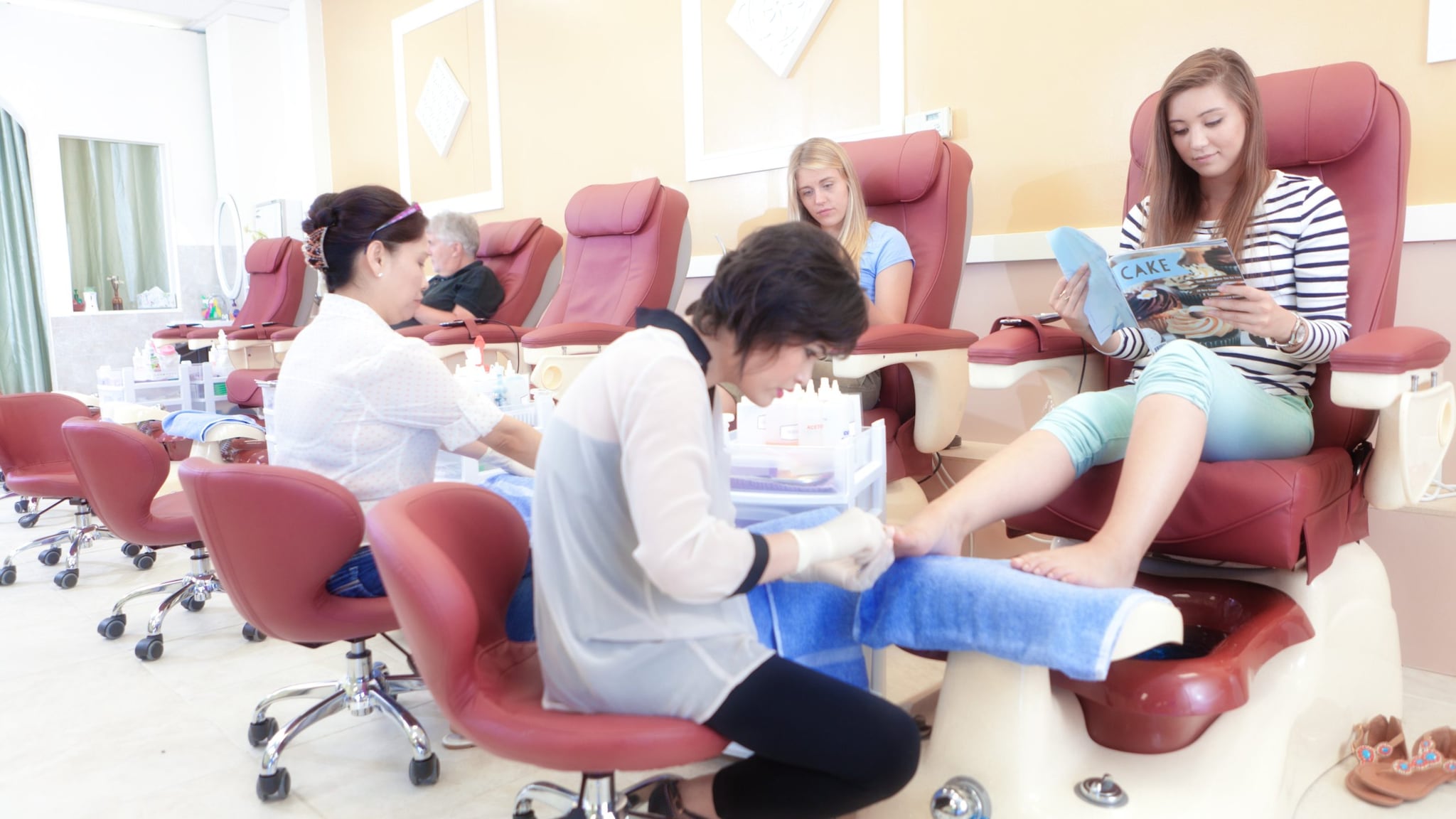At a glance
- Nail technicians can be exposed to chemical and physical hazards at work.
- Overexposure to certain chemicals can cause different types of health effects, including respiratory, neurological, reproductive, and more.
- Nail technicians are also at risk for musculoskeletal problems from awkward postures and repetitive motions.
- There are ways employers and workers can reduce nail technicians' health risks.

Overview
Nail salon workers, or nail technicians, perform work tasks that can put them at risk for negative health outcomes. Nail technicians are potentially exposed to dozens of chemicals at work. Repetitive motions and awkward positions can also strain their muscles, joints, and ligaments.
In the United States, there are over 400,000 active nail technicians.1 These workers are largely:
Approximately 46% of nail technicians born outside of the United States do not speak English well.2
Hazards and exposures
Chemical hazards
Nail products often contain many chemical ingredients. Some common chemicals in these products include:
- Acetone
- Dibutyl phthalate
- Ethyl acetate
- Formaldehyde
- Methacrylate compounds
- Toluene
- Triphenyl phosphate
Workers can breathe in the dusts or vapors from these chemicals, absorb them through the skin, or ingest them. Depending on the exposure, some chemicals in nail salon products can cause health problems like:
- Skin rash or contact dermatitis
- Eye, nose, throat irritation
- Asthma
- Neurological effects
- Reproductive problems
- Cancer
Physical hazards
Nail technicians might use awkward postures during work tasks. For example, they might lean over a table during manicures or hunch down to perform pedicures. They also perform repetitive motions, such as filing nails. Awkward postures and repetitive motions put them at risk for developing musculoskeletal disorders.
Best practices
Reducing chemical exposures
Ventilation
Good ventilation can reduce the level of chemicals in the air. In addition to general room ventilation, nail salons can use local exhaust ventilation controls at workstations.3
Local exhaust ventilation can come in many forms, such as:
- Portable units that filter or exhaust air to the outdoors
- Downdraft ventilated tables
Other ways to reduce workers' exposure to chemicals
- Use pressure-sensitive dispenser bottles with small openings 3
- Keep chemical containers closed3
- Avoid eating or drinking in the work area3
- Wear personal protective equipment, such as gloves3 and N95® filtering facepiece respirator4

Reducing musculoskeletal strain
Using equipment that improves posture, such as an adjustable chair, and taking breaks can help reduce the risk for musculoskeletal issues. See more best practices for nail technicians on the Occupational Safety and Health Administration (OSHA) website. Employers can use the NIOSH Elements of Ergonomics Programs to help reduce workers' musculoskeletal disorders.
Spotlight
A recent NIOSH Science blog discusses NIOSH work on researching the risk of birth defects among pregnant nail salon workers and hairdressers. NIOSH researchers found mothers who gave birth to infants with a congenital heart defect were roughly 3 times more likely than mothers of infants with no birth defect to have worked as a nail technician during early pregnancy.
The blog is also available in Vietnamese and Korean.
Research
See the NIOSHTIC-2 database search results on nail technicians and nail salons. NIOSHTIC-2 is a database of occupational safety and health publications funded in whole or in part by NIOSH.
Resources
Occupational Safety and Health Administration (OSHA) resources
Health Hazards in Nail Salons. This website includes information and steps that nail salon workers and employers can take to prevent injuries and illnesses.
Stay Health and Safe While Giving Manicures and Pedicures. This guide provides information for workers on possible hazards, good work practices, and their rights.C
Contact CDC/NIOSH
If you have questions about this topic, please contact CDC-INFO.
- Nails Magazine, 2017-2018 industry statistics. Available: https://beautyimages.bobitstudios.com/upload/_migratednails/files/Handouts/NABB2017-18stats-LR.pdf
- UCLA Labor Center and California Healthy Nail Salon Collaborative, 2018, Nail Files: A Study of Nail Salon Workers and Industry in the United States. Available: https://www.labor.ucla.edu/wp-content/uploads/2018/11/NAILFILES_2019jan09_FINAL_5a.pdf
- NIOSH [1999]. NIOSH hazards controls HC28 - controlling chemical hazards during the application of artificial fingernails. Cincinnati, OH: U.S. Department of Health and Human Services, Public Health Service, Centers for Disease Control and Prevention, National Institute for Occupational Safety and Health, DHHS (NIOSH) Publication No. 99-112, (HC 28), 1999 Jan; :1-2, https://www.cdc.gov/niosh/docs/99-112/
- Estill CF, Mayer A, Slone J, Chen I-C, Zhou M, La Guardia MJ, Jayatilaka N, Ospina M, Calafat A (2021). Assessment of triphenyl phosphate (TPhP) exposure to nail salon workers by air, hand wipe, and urine analysis. Int J Hyg Environ Health 231(113630). doi:10.1016/j.ijheh.2020.113630
